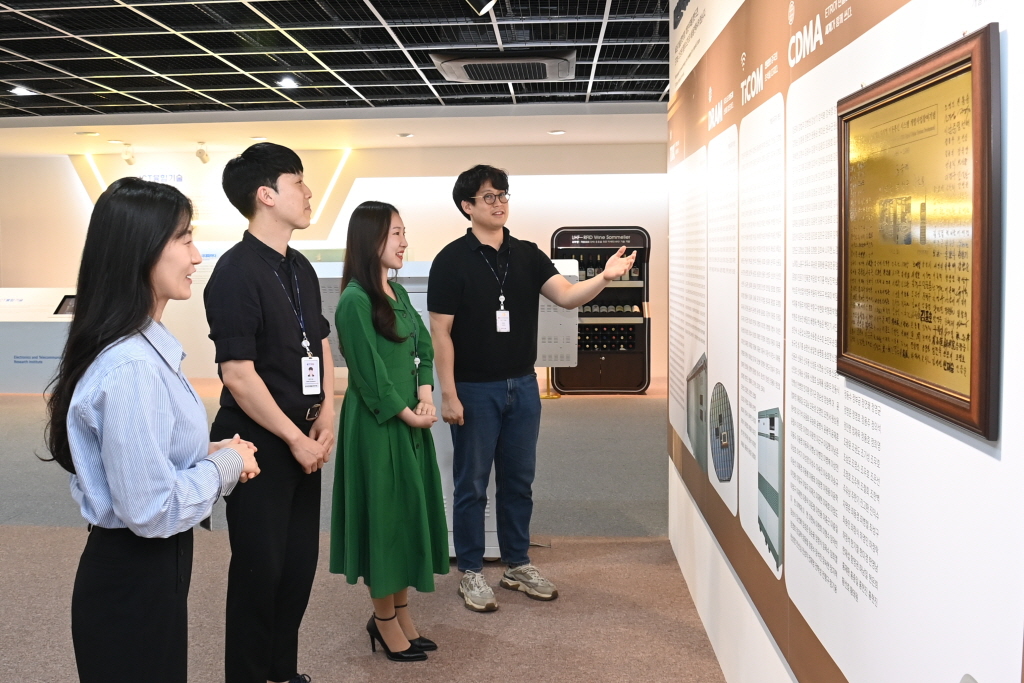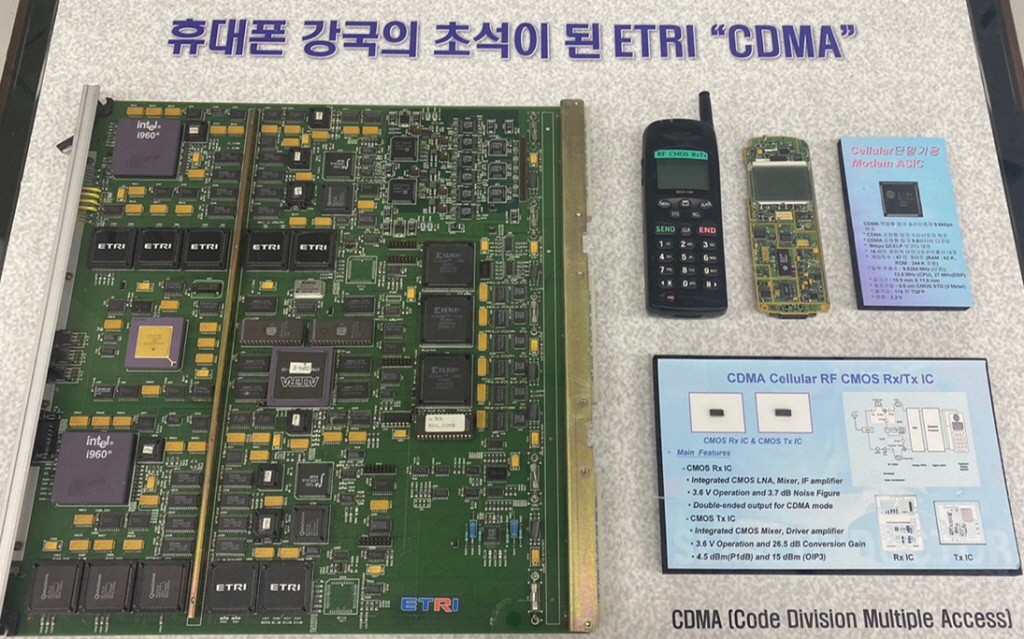한국전자통신연구원(ETRI)이 연구원 본관동 2층에 연구진이 지난 48년간 이룬 세계 최고의 연구성과물 68점을 전시, 일반에 공개했다.

▲ETRI 역사관을 둘러보는 ETRI 직원들
본관동 성과전시, TDX·DRAM·CDMA·WiBro 등 주요성과 68점 전시
정보통신기술(ICT) 강국을 건설한 연구진들의 피땀이 배어있는 연구성과물이 드디어 세상에 빛을 보게 됐다.
한국전자통신연구원(ETRI)은 23일 연구원 본관동 2층에 연구진이 지난 48년간 이룬 세계 최고의 연구성과물 68점을 전시, 일반에 공개한다고 밝혔다.
연구원이 공개한 주요 성과물은 △반도체 △통신 △방송미디어 △컴퓨터 △ICT융합 등 5대 연구부문의 연구성과물로 시대순으로 구분해 전시했다.
세계최고, 세계최초의 ICT 역사를 쓴 연구진의 도전정신과 불굴의 의지가 담겨 있다.
ETRI는 지난 1976년 척박한 토양에서 통신과 전자의 씨앗을 뿌렸다.
수많은 시련과 역경 속에서도 연구진은 정보통신 핵심기술 개발을 선도하며 대한민국 ICT의 발전을 이끌어 왔다.
연구진이 일군 기술료 누적금액은 1조1,674억원이다.
특히 이날 공개한 전시물 중 전전자교환기(TDX), 반도체(DRAM), 디지털이동통신시스템(CDMA), 휴대인터넷(WiBro) 기술은 정부가 지난 2015년, 광복 70주년을 맞아 선정한 70대 대표성과에 이름을 올린 대한민국의 국보급 기술이다.
먼저 반도체 부문은 디스플레이 기술개발과 더불어 대한민국 ‘산업의 쌀’로 불리며 기술강국 신화를 창조한 분야다.
소재/부품 기술을 선제적으로 개발해 국가경쟁력을 높이고 최고의 주력 수출품으로 부상해 국가발전에 큰 기여를 했다.
연구진은 1989년 4M DRAM 개발을 비롯, 세계 최초로 64M DRAM을 개발해 우리나라를 세계 1위 반도체 수출강국의 반열에 올려놓았다.
아울러 2009년 유기발광다이오드(OLED), 투명유기발광다이오드(AMOLED) 패널도 세계최초로 개발해 우리나라를 디스플레이 최강국으로 견인했다.
현재는 차세대 마이크로 LED디스플레이와 지능형반도체 기술개발을 통해 반도체 초강국의 격차를 벌이며 노력 중이다.
통신 부문은 명실상부 세계 최강이다.
1986년 1가구 1전화 시대를 연 전전자교환기(TDX) 개발을 시작으로 1995년 이동통신 선진국으로 발판을 마련한 CDMA기술을 개발해 우리나라를 이동통신강국으로 만들었다.
이후 최초의 휴대인터넷 기술인 와이브로(WiBro)를 2004년 개발해 이동통신강국의 위치를 단단하게 다졌다.
이후 LTE기술을 통해 3G, 4G기술을 세계최초로 개발에 성공했고 5G까지 이어지는 성공신화를 써 내려갔다.
연구진은 이제 새로운 도전으로 6G 이동통신개발에도 핵심으로 참여, 이동통신 최강국의 역할과 책임을 다하고 있다.
방송미디어 부문에서 연구진은 세계 최고수준의 방송미디어 기술을 개발하고 국내·외 표준화를 견인해 왔다.
1998년 지상파 디지털TV 개발을 시작으로 내 손 안의 TV시대를 열게 된 디지털멀티미디어방송(DMB)을 2006년 세계최초로 개발해 이동중에도 TV를 볼 수 있게 되었다.
또한 2016년 초고화질(UHD) TV의 핵심기술인 전송기술과 압축기술을 개발해 국제표준화(ATSC)로 만들어 세계인이 함께 보는 UHDTV 시대를 활짝 열어가고 있다.
컴퓨터 부문에서도 ETRI는 눈부신 역할로 세상을 바꿔가고 있다.
ETRI는 1982년 세계에서 두 번째 인터넷 연결에 성공하고, 1983년 우리나라 최초의 8비트 교육용컴퓨터 개발을 시작으로 16비트, 32비트 유닉스 컴퓨터 개발을 해냈다.
1991년 행정전산망용 주전산기인 타이컴(TiCOM)개발을 통해 우리나라를 전자정부의 기틀을 마련했다.
이후 컴퓨터, SW, 기술개발을 통해 기술독립과 산업발전에 힘써왔다.
최근에는 자동 통·번역 기술 등 인공지능 기술 개발을 통해 세계를 깜짝 놀라게 만들고 있다.
마지막으로 ICT융합기술 분야에서 ETRI는 자동차, 조선, 국방, 에너지 등 다양한 기술분야에 ICT기술을 적용함으로써 새로운 산업의 가치를 극대화하는 데 힘써 왔다.
특히 사물인터넷(IoT), 지능로보틱스, 바이오/의료, 우정물류, 에너지·안전·국방 등 국가 아젠다 해결형 융합연구 등을 통해 학문 간 융합과 발전에 큰 공헌을 했다.
대표적인 기술로 2010년 선박네트워크(SAN) 기술과 무인식별(RFID), 지능형 로봇 기술, 2013년 무인 발렛주차 기술개발 등이 있다.
연구원은 역사관 중앙홀에 ETRI를 빛낸 주요 성과 연구자의 이름을 새겨 명패로 보존하고 후배 연구진의 귀감으로 삼고 있다.
과거 장거리자동전화(DDD)와 카드식 공중전화, 화상전화 등도 전시해 통신강국을 견인해 온 ETRI의 명성도 보여줬다.
아울러 대전시의 자랑인 타슈 자전거에도 연구진의 RFID기술이 내장되어 있으며, 고속도로 톨게이트의 과금 기술, 초등생 영어교육의 ‘펭톡’, 영화 ‘명량’의 컴퓨터그래픽(CG)기술, 영상압축기술인 엠펙(MPEG)에도 연구진의 기술혼이 숨 쉬고 있다.
우리나라 최초의 인공위성을 쏘아 올린 故최순달 전 체신부장관과 TDX개발의 주역인 故안병성 박사가 과학기술유공자에 선정되었고, 故최순달 장관은 국립대전현충원 국가사회공헌자 묘역에 안장되었다.
ETRI 방승찬 원장은 “이번 조성한 연구원의 역사관은 단순히 그동안의 연구성과물을 모아놓은 곳이 아닌 우리나라의 ICT역사가 숨 쉬는 곳이다. 고객들에게 우리나라가 어떻게 ICT 최강국이 되었는지 보여주게 되어 큰 의미가 있다”고 말했다.
ETRI는 정보통신전시관과 함께 역사관 관람을 일반인들에게 연계해 관람케 함으로써 ICT의 역사와 미래를 함께 보여준다는 취지다.
아울러 ETRI는 오는 2026년, 새롭게 건축되는 마중물플라자에 본 기술들을 함께 전시해 명실상부, 대한민국 ICT 전시관 구축에도 노력하고 있다.

▲CDMA
